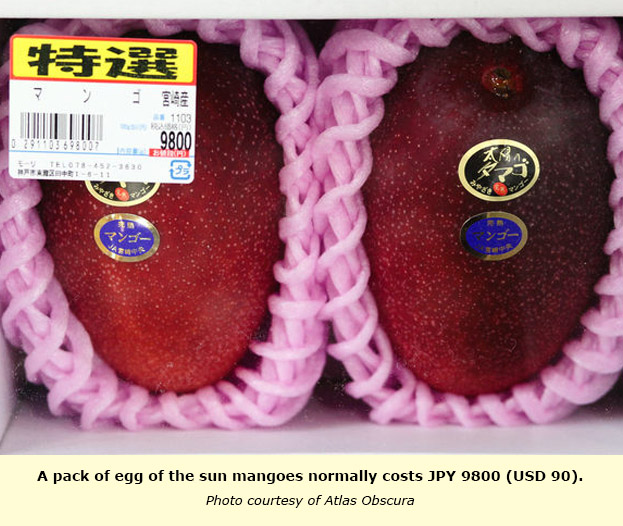In 2017, two mangos sold at a Japanese wholesale auction for a record-breaking USD 3,744. Taiyo no Tamago (Egg of the Sun) is a variety of mango grown in the Miyazaki prefecture and sold throughout Japan. Although they don’t usually go for thousands of dollars, on any given day you would be hard-pressed to find one for less than USD 50. The question is: What makes these mangoes so expensive?
If you think the high cost has anything to do with rarity, you’d be wrong. Egg of the Sun mangoes are actually a surprisingly common cultivar known as Irwin, which originated in Florida in the 1940s. Today, a Miami fruit stand will sell one for only a few dollars.

The hefty price tag is partially due to the care that goes into growing these fruits. Japanese farmers surround each mango with a small net, which allows sunlight to hit the skin at all angles (giving it a uniform, ruby-red color), and cushions the fruit when it falls from the tree. Allowing the mangoes to simply fall when they’re ready, as opposed to manually picking them, ensures optimal ripeness. The resulting mangoes are absolutely delicious. They have very little fibrousness, are extremely juicy, and practically melt in your mouth. The taste itself is perfectly sweet and tart, like mango candy with hints of pineapple and coconut.
But even more important than delicious flavors and meticulous care is Japan’s gift-giving culture. It is a sign of respect to give gifts for business dealings, for special occasions and social events, or when returning home after traveling (known as omiyage). High-quality, expensive fruits are a valued symbol of respect within this practice.
Often, meticulously packaged gift fruits are sold behind glass cases at luxury fruit stores, as if they were jewels. Those who receive these perishable gifts will often put them on display and, in the case of certain fruits such as the square watermelon (which is sold under-ripe), they may never be eaten. So although Miyazaki’s mango is arguably more delicious than its Floridian counterpart, the majority of its price tag comes from what it represents.
Need to Know
Luxury fruit stores exist in cities throughout Japan—often located in high-end shopping centers and department stores—and will often carry a few prime Egg of the Sun mangoes. One of the most well known shops is Tokyo’s Sembikiya, which has several retail locations. Even if you don’t intend on buying anything, it makes a fascinating place to window shop. If you don’t care about getting the top end mangoes (and there is little reason to if you’re buying this for yourself), you may find Miyazaki mangoes at large supermarkets. Many will have a small section of fruits intended for gift-giving available, often for far cheaper.
